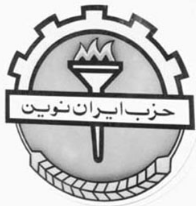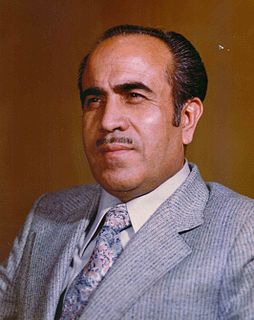| |||||||||||||||||||||||||||||||||||||||||||||||||||||||||||||
All 270 seats to the National Consultative Assembly 136 seats are needed for a majority | |||||||||||||||||||||||||||||||||||||||||||||||||||||||||||||
|---|---|---|---|---|---|---|---|---|---|---|---|---|---|---|---|---|---|---|---|---|---|---|---|---|---|---|---|---|---|---|---|---|---|---|---|---|---|---|---|---|---|---|---|---|---|---|---|---|---|---|---|---|---|---|---|---|---|---|---|---|---|
| Registered | 20,758,391 [1] | ||||||||||||||||||||||||||||||||||||||||||||||||||||||||||||
| Turnout | 52.14% [1] | ||||||||||||||||||||||||||||||||||||||||||||||||||||||||||||
| |||||||||||||||||||||||||||||||||||||||||||||||||||||||||||||
| |||||||||||||||||||||||||||||||||||||||||||||||||||||||||||||
Parliamentary elections were held in Iran on 13 March 1980, with a second round on 9 May. [4] They were the first elections to the Majlis since the overthrow of the Shah, and were contested to a considerable degree on a party basis. [5]

Iran, also called Persia, and officially the Islamic Republic of Iran, is a country in Western Asia. With over 81 million inhabitants, Iran is the world's 18th most populous country. Comprising a land area of 1,648,195 km2 (636,372 sq mi), it is the second largest country in the Middle East and the 17th largest in the world. Iran is bordered to the northwest by Armenia and the Republic of Azerbaijan, to the north by the Caspian Sea, to the northeast by Turkmenistan, to the east by Afghanistan and Pakistan, to the south by the Persian Gulf and the Gulf of Oman, and to the west by Turkey and Iraq. The country's central location in Eurasia and Western Asia, and its proximity to the Strait of Hormuz, give it geostrategic importance. Tehran is the country's capital and largest city, as well as its leading economic and cultural center.

Shah is a title given to the emperors, kings, princes and lords of Iran. It was also adopted by the kings of Shirvan namely the Shirvanshahs. It was also used by Persianate societies such as the rulers and offspring of the Ottoman Empire, Mughal emperors of the Indian Subcontinent, the Bengal Sultanate, as well as in Afghanistan. In Iran the title was continuously used; rather than King in the European sense, each Persian ruler regarded himself as the Shahanshah or Padishah of the Persian Empire.
Contents
It resulted in a victory for the Islamic Republican Party, which won 85 of the 270 seats, whilst its allies who a further 45. [4] The party, joined by smaller Islamist groups in the Grand coalition was a highly organized force and put up candidates in most constituencies and dominated the campaigns, especially in the provinces. [6]

The Islamic Republican Party formed in mid-1979 to assist the Iranian Revolution and Ayatollah Khomeini establish theocracy in Iran. It was disbanded in May 1987 due to internal conflicts.

The Grand Coalition was the political alliance of Islamist groups contesting in the Iranian legislative election, 1980, led by the Islamic Republican Party. Various small fundamentalist groups joined the alliance.
President Abolhassan Banisadr and his followers, presented dozens of candidates in Tehran and provinces under the list Office for the Cooperation of the People with the President. [6]

Seyyed Abolhassan Banisadr is an Iranian politician. He was the first President of Iran after the 1979 Iranian Revolution abolished the monarchy, serving from 4 February 1980 until he was impeached by parliament on 20 June 1981. Prior to his presidency, he was the minister of foreign affairs in the interim government. He has resided for many years in France where he co-founded the National Council of Resistance of Iran. At age 86, Banisadr is currently the oldest living former Iranian President.
Office for the Cooperation of the People with the President was a political entity in Iran close to then-President Abolhassan Banisadr. It was an “office” "that was created out of necessity to fulfil some, if not all, of the functions of a political party".
Freedom Movement of Iran which lost the chance to organize effectively, fielded at most only 40 candidates under the banner of Eponym Group [6] and won about 20 seats. [5]

The Freedom Movement of Iran (FMI) or Liberation Movement of Iran is an Iranian pro-democracy political organization founded in 1961, by members describing themselves as "Muslims, Iranians, Constitutionalists and Mossadeghists". It is the oldest party still active in Iran and has been described as a "semi-opposition" or "loyal opposition" party. It has also been described as a "religious nationalist party".
The Eponym Group was an electoral list for the Iranian legislative election, 1980 claiming "it would choose its candidates based on merit without regard to party affiliation". Close to the Freedom Movement, the group formed a minority in the parliament with approximately 15 to 23 seats. Due to internal conflicts, the Freedom Movement did not issue a list but its members were included in the Eponym list. The list had members of Freedom Movement, JAMA and Islamic Republican Party.
Among National Front candidates, four won the election but their credentials was rejected on the grounds such as being "landlord" or "American agent" and they did not take seat. Its leader Karim Sanjabi withdrew in the run-off because of the alleged "irregularities". [2] [3]

The National Front of Iran is an opposition political organization in Iran, founded by Mohammad Mosaddegh in 1949. It is the oldest and arguably the largest pro-democracy group operating inside Iran despite having never been able to recover the prominence it had in the early 1950s.

Karim Sanjabi was an Iranian politician of National Front.
Under the name Progressive Revolutionary Candidates list, People's Mujahedin of Iran endorsed 127 nominees nationwide and the official counts gave them as much as 20% of the votes in some constituencies, however they failed to win any seats. Its leader Massoud Rajavi received 531,943 votes in Tehran but was defeated in the run-offs. [7]

The People's Mojahedin Organization of Iran or the Mojahedin-e Khalq is an Iranian political–militant organization based on Islamic and Socialist ideology and advocates overthrowing the Islamic Republic of Iran leadership and installing its own government. It was the "first Iranian organization to develop systematically a modern revolutionary interpretation of Islam – an interpretation that deferred sharply from both the old conservative Islam of the traditional clergy and the new populist version formulated in the 1970s by Ayatollah Khomeini and his government." The MEK is considered the Islamic Republic of Iran's biggest and most active political opposition group.

Massoud Rajavi is one of the two leaders of the People's Mujahedin of Iran (MEK), alongside his wife Maryam Rajavi. After leaving Iran in 1981, he resided in France and Iraq. He disappeared in the 2003 invasion of Iraq and it is not known whether he is still alive.

Tehran, Rey, Shemiranat and Eslamshahr is a constituency for the Islamic Consultative Assembly.
Tudeh Party lacked popularity and did poorly, [8] with their highest ranked candidate in Tehran receiving only some 100,000 votes. The party was unable to persuade other left-wing groups to unite. [9]















